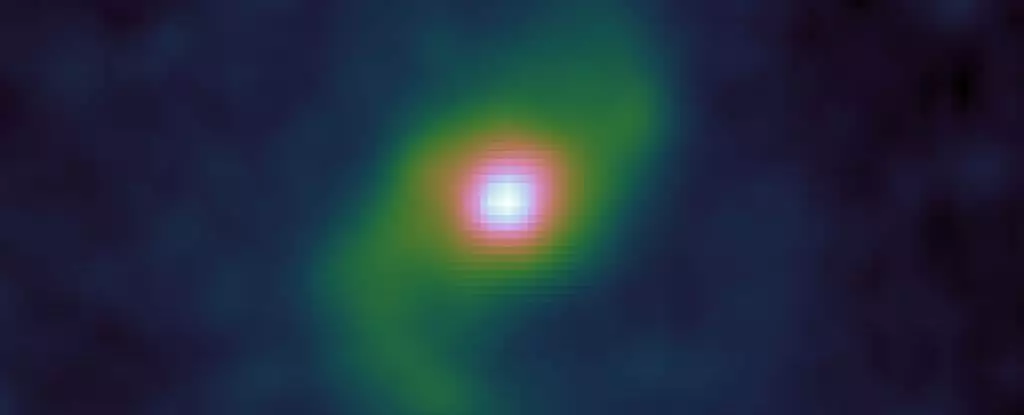The field of astronomy is on the brink of a remarkable transformation with the recent discovery of ancient celestial formations that challenge our understanding of galactic evolution. Specifically, the revelation of a magnificent spiral galaxy named J0107a, formed merely 2.6 billion years after the Big Bang, not only offers a glimpse into the early universe but also raises profound questions about the mechanisms of galaxy development. This instance of cosmic architecture, complete with a stable galactic bar, marks a significant milestone in our comprehension of galaxy formation, pushing the boundaries of what we thought was possible in the early stages of cosmic history.
The Unforeseen Complexity of Galactic Bars
Galactic bars, those long, sweeping structures that often cut through the centers of galaxies, have long been considered hallmarks of mature galaxies. The existence of J0107a’s robust bar—indicating not just structural stability but also a sophisticated evolution of the galaxy—is surprising to astronomers. Traditionally, it was posited that large-scale structures such as these would only emerge after galaxies had ample time to coalesce and evolve through gravitational interactions and gas accretion. However, this new discovery highlights an accelerated evolutionary path, fundamentally altering our understanding of how galaxies grew and organized themselves during the universe’s infancy.
What is particularly compelling about J0107a is the similarity it shares with local galaxies like our very own Milky Way. Shuo Huang, part of the research team, expressed astonishment at this finding, indicating that the gas dynamics within J0107a exhibit characteristics reminiscent of galaxies much further along in the evolutionary timeline. This suggests that processes facilitating galaxy growth may have been operational far earlier than previously believed, challenging established models that depict a gradual formation of complex galactic structures.
Unpacking the Mechanisms of Growth
The observed star formation rate within J0107a is staggering, at approximately 500 solar masses per year, with gas being funneled towards its core at an even higher rate of 600 solar masses per year—an astonishing 10 to 100 times more efficient than comparable processes in present-day galaxies. This accelerated rate begs the crucial question: what mechanisms allowed such rapid star formation and gas accumulation to occur?
Researchers speculate that the inflow of gas from the cosmic web—a network of intergalactic gas that permeates the universe—may have played a pivotal role in forming the giant disk of J0107a. The implication is revolutionary: rather than slow mergers and a gradual buildup, initial galaxy formation may have been influenced more by a direct influx of cold gas, reshaping how we visualize the timeline of galactic evolution. However, Huang cautions that while the gas distribution and motion appear similar to contemporary galaxies, the actual star formation processes may differ significantly due to altered gas densities.
Rethinking Galactic Evolution: A Paradigm Shift?
The ramifications of this research extend far beyond the isolated case of J0107a; they call into question the reliability of current theoretical models on the evolution of galaxies. As astronomers reconcile this new data with existing frameworks, it becomes clear that the standard narratives surrounding how galaxies emerged and matured might need revisiting. The idea that early galaxies could have been complex and well-structured entities suggests a reevaluation of the timeline and processes involved in cosmic evolution.
Furthermore, the discovery of J0107a raises several pressing inquiries into the nature of intergalactic gas streams and their relationship to galaxy formation. Researchers are now tasked with investigating how this cosmic gas arrives at galaxies like J0107a and contributes to their stellar growth. What remains mysterious is the interplay between gas density and star formation rates—could it be that J0107a is an anomaly, representing a unique evolutionary path, or might it be indicative of a more common occurrence in the early universe?
The Call for Future Exploration
As we stand on the precipice of a new era in astronomical research, the implications of the discovery of J0107a are profound. Future observations utilizing powerful telescopes and advanced observational techniques are essential for deepening our understanding of these ancient cosmic objects. By probing the characteristics of J0107a and potentially other similar galaxies, astronomers hope to unlock the secrets of early galactic development. While many questions remain unanswered, the adventure of unraveling cosmic mysteries is one that promises to reshape our understanding of the universe and our place within it.

